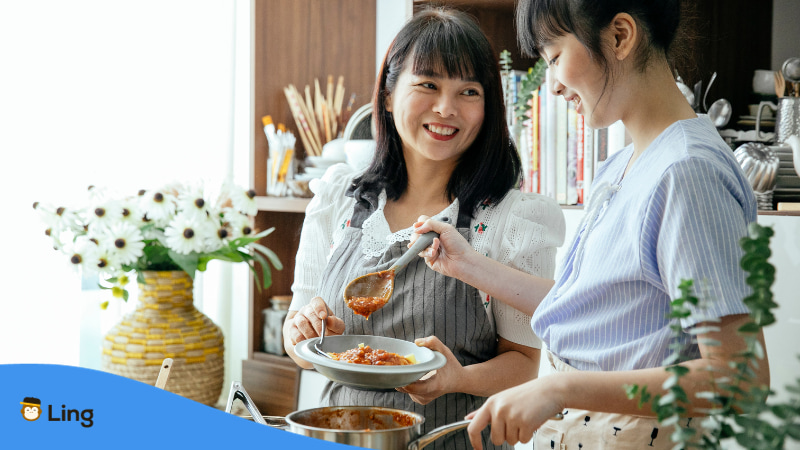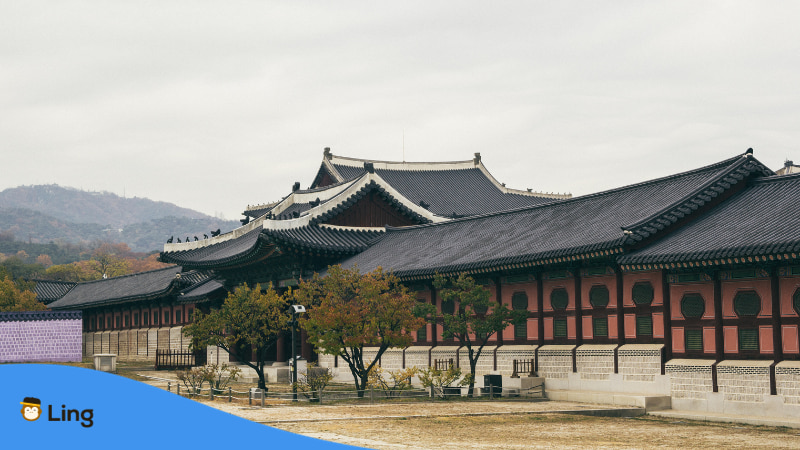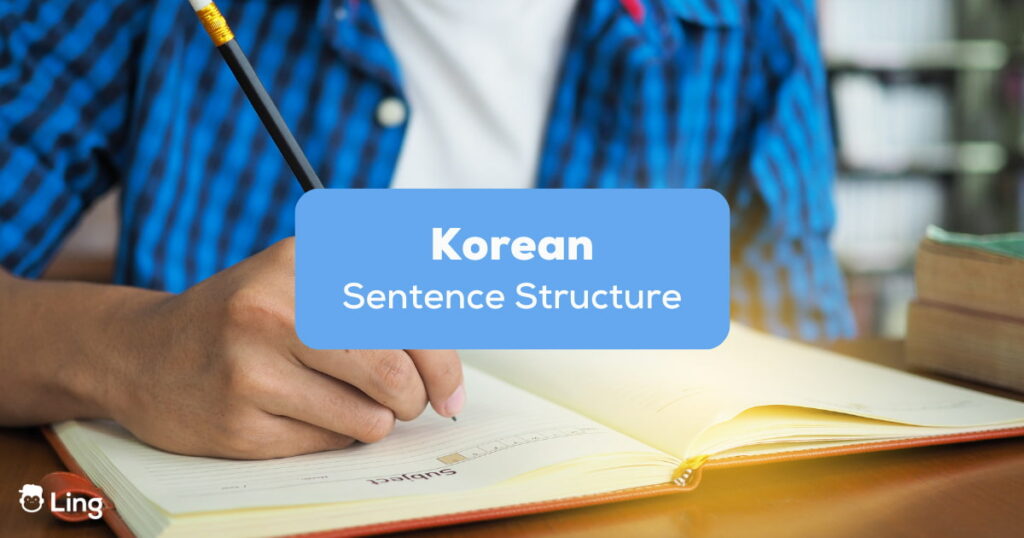Interested to learn the intricacies of the Korean sentence structure? We’ve got another cool blog perfect for Korean language learners just like you. I know you all are desperately trying to learn Korean as soon as possible so that you can speak Korean like a native speaker and connect with the locals in a much deeper way.
However, this Asian language seems too difficult to master, especially since it has a different writing system than the Latin one, which we are all used to. To help you all out, learn the basics today in this post.
Basic Korean Sentence Structure
The basic Korean sentence structure has a subject-object-verb (SOV) order. This basic sentence structure is different from the English sentence structure, i.e., subject-verb-object (SVO) order.
Korean Language And Culture
Korean sentence structure gives a glimpse into Korean culture, indicating that in Korean culture, the value of the main characters in a certain situation is more important than the action that they are involved in. Therefore, the subject and the object are written together, while the verb comes afterward.
There is absolutely no way to make sentences in Korean without knowing some vocabulary. All Korean Language learners should at least know the basic words in the Korean language to make a sentence. So in order to craft complete sentences, you need to learn the common Korean vocabulary and basic Korean words.
In addition, to learn basic Korean sentence structures, it is important to have knowledge of Korean grammar and sentence patterns. The basic word order in Korean grammar uses nouns and verbs. In this blog, you will get countless examples of using verbs to make sentences.
Most common sentence structures in the Korean language have a typical sentence pattern. That is the subject-object-verb structure. Another Korean sentence structure is a Subject Adjective sentence pattern. This is also the most basic sentence structure. Besides the SVO and SV order, another order is the SA order (Subject-adjective) order in the Korean language. Korean language learners should know how to form a simple sentence using either a verb or an adjective.

Korean Subject
Subject refers to the noun that the entire sentence is about. It is the main component of any sentence. To understand and study the subjects in the Korean language, it is important to first understand them in the English language.
For instance, in the sentence “I am a girl,” the word/ noun “I” is the subject of the sentence since the entire sentence is about “I.” The subject in a Korean sentence is written at the start of the sentence. It is usually marked with a topic marker “은/는” or a subject marker “이/가” with the nouns as subjects to be specific.
Table Of Basic Korean Sentences Using Subject Marker
The following table will help you understand basic Korean sentence structure easily. Read it slowly and practice!
| English Sentence | Korean Sentence | Subject | Topic Marker |
|---|---|---|---|
| I am a girl | 나는 소녀입니다 | 나 (I) | 는 |
| You are a girl | 당신은 여자입니다 | 당신 (You -formal) | 은 |
| She is a girl | 그녀는 소녀이다 | 그녀 (She) | 는 |
| The girl is tall | 소녀는 키가 크다 | 소녀 (Girl) | 는 |
| My house is big | 내 집은 크다 | 집 (House) | 은 |
| Your eyes are beautiful | 당신의 눈은 아름답습니다 | 눈 (Eyes) | 은 |
| He hates you | 그는 당신을 싫어 | 그 (He) | 는 |
| She likes cooking | 그녀는 요리를 좋아한다 | 그녀 (She) | 는 |
| I like dancing | 나는 춤추는 것을 좋아한다 | 나 (I) | 는 |
Combining the subject marker with the subject I “나” becomes “난.” For instance, in the sentence “I like you,” i.e., “난 너를 좋아해.” However, as a rule of thumb, just remember the “은/는” topic markers or “이/가” subject markers, which are used in most of the sentences.
Korean Object
The object is the word/ noun which the subject is usually acting upon. Object refers to the noun that the subject is putting the action on. In basic Korean sentence structures, the objects are placed between the subjects and the verbs.
For instance, in an English sentence (I hit you), “you” is an object since the subject “I” performs the action on “you,” thus becoming the object.
Object Markers (Korean Particles)
To mark the objects in the sentence, the Korean particles used are “를/을.” These are the object markers that are present in all the sentences having an object in them.

Table Of Basic Korean Sentences Using Object Particle
Here is a table for you with example sentences using the object particles to understand this better.
| English Sentence | Korean Sentence | Object | Object Marker |
|---|---|---|---|
| You like ice cream | 당신은 아이스크림을 좋아합니다 | 아이스크림 (Ice-cream) | 을 |
| She plays tennis | 그녀는 테니스를 친다 | 테니스 (Tennis) | 를 |
| I cook lunch | 나는 점심을 요리한다 | 점심 (Lunch) | 을 |
| The boy drinks tea | 소년은 차를 마신다 | 차 (Tea) | 를 |
| I buy a house | 나는 집을 산다 | 집 (House) | 을 |
| She draws eyes | 그녀는 눈을 그립니다 | 눈 (Eyes) | 을 |
| You killed him | 당신이 그를 죽였다 | 그 (He) | 를 |
| He pushed her | 그는 그녀를 밀었다 | 그녀 (She) | 를 |
| He kicked me | 그는 나를 찼다 | 나 (I/me) | 를 |
Korean Verb
The verb is a word that is used to describe an action. It is an action word. A sentence following an SOV order always has a subject-verb in it. The subject-verb draws the connection between the subject and the object of a sentence.
The verbs mark the sentence endings in the particular sentence pattern. There is no specific marker for the verbs in English. However, in Korean, the verbs are usually marked with “다”.
For instance, 먹다 (to eat), 앉다 (to sit), 쓰다 (to write), etc.
Table Of Basic Korean Sentences Using Verb Particle
Here is a table for you to understand how the verb markers work better using different verbs.
| English Sentence | Korean Sentence | Subject-Verb | Verb Marker |
|---|---|---|---|
| You like ice cream | 당신은 아이스크림을 좋아합니다 | 좋아합니 (like) | 다 |
| She plays tennis | 그녀는 테니스를 친다 | 친 (play) | 다 |
| I cook lunch | 나는 점심을 요리한다 | 요리한 (cook) | 다 |
| The boy drinks tea | 소년은 차를 마신다 | 마신 (drink) | 다 |
| I buy a house | 나는 집을 산다 | 산 (Buy) | 다 |
| She draws eyes | 그녀는 눈을 그립니다 | 그립니 (draw) | 다 |
| You killed him | 당신이 그를 죽였다 | 죽였 (kill) | 다 |
| He pushed her | 그는 그녀를 밀었다 | 밀었 (push) | 다 |
| He kicked me | 그는 나를 찼다 | 찼 (kick) | 다 |
Subject-Object-Verb Order
In the subject-object-verb order, the Subject is written first, the object in a sentence comes after that, and the Verb follows the entire sentence. It is a very important rule to master since it is the most used Korean language sentence structure in the Korean language.

Table Of Basic Korean Sentences Using SOV Order
Using the markers and examples mentioned earlier, here is a table for you to get the entire sentence using subject-object verb order.
| Sentence | Subject | Object | Subject Verb |
|---|---|---|---|
| 당신은 아이스크림을 좋아합니다 (You like ice cream) | 당신은 (You) | 아이스크림을 (Ice-cream) | 좋아합니 (like) |
| 그녀는 테니스를 친다 (She plays tennis) | 그녀는 (She) | 테니스를 (Tennis) | 친 (play) |
| 나는 점심을 요리한다 (I cook lunch) | 나는 (I) | 점심을 (Lunch) | 요리한 (cook) |
| 소년은 차를 마신다 (The boy drinks tea) | 소년은 (The boy) | 차를 (Tea) | 마신 (drink) |
| 나는 집을 산다 (I buy a house) | 나는 (I) | 집을 (House) | 산 (Buy) |
| 그녀는 눈을 그립니다 (She draws eyes) | 그녀는 (She) | 눈을 (Eyes) | 그립니 (draw) |
| 당신이 그를 죽였다 (You killed him) | 당신이 (You) | 그를 (He) | 죽였 (kill) |
| 그는 그녀를 밀었다 (He pushed her) | 그는 (He) | 녀를 (She) | 밀었 (push) |
| 그는 나를 찼다 (He kicked me ) | 그는 (He) | 나를 (I) | 찼 (kick) |
Subject-Verb Sentence
There are various cases in which someone asks you a certain question. The question could be about your job, career, hobbies, name, or anything. There are two ways of answering. One way is providing the entire information, while the other way is by giving a direct answer.
Example
For instance, “하시는 일이 뭐에요?” (What do you do for a living?). To answer these questions, you can give a direct answer and say “나 요리 해” (I cook).
Table Of Basic Korean Sentences Using SV Order
Using the markers and examples mentioned earlier, here is a table for you to get the entire sentence using subject-verb order.
| Sentence | Subject | Verb |
|---|---|---|
| 나는 일한다 (I work) | 나는 (I) | 일한다 (work) |
| 너는 미소지었다 (You smiled) | 너는 (You -informal) | 미소지었다 (smile) |
| 그녀는 잔다 (She sleeps) | 그녀 (She) | 잔다 (sleep) |
| 새가 날다 (Birds fly) | 새가 (Birds) | 날다 (Fly) |
| 소년은 잔다 (Boy sleeps ) | 소년은 (Boy) | 잔다 (sleeps) |
| 눈이 빛난다 (Eyes shine) | 눈이 (Eyes) | 빛난다 (Shine) |
| 그는 말한다 (He speaks) | 그는 (He) | 말한다 (Speaks) |
| 암소 씹다 (Cow chews) | 암소 (cow) | 씹다 (Chew) |
| 그는 먹는다 (He eats) | 그는 (He) | 먹는다 (Eat) |
Subject Adjective Sentence
There are various sentences in which there is a subject and adjective only. Such sentences do not have any objects or verbs. Korean sentence structure for such Korean sentences is SA word order (Subject Adjective order). This is the same structure followed by the other Korean sentence structures where the adjective replaces the other parts.
In such a Korean language sentence structure, the topic markers and subject markers are still utilized to mark the subject.

Adjectives In The Korean Language
Adjectives refer to the words which provide a description for the nouns. These are the words that describe the quality of a certain noun. In the sentence “나는 좋다” (I am good), the word “좋다” means good, and since it describes the characteristic/quality of another noun (subject) “나는,” therefore, it is an adjective.
The marker of adjectives is usually the same as that of verbs which is “다”.
Example
For instance, “쓰다” (Bitter), “심심하다” (Bored), and “씩씩하다” (Brave), etc.
Table Of Basic Korean Sentences Using SA Order
Using the marker and examples mentioned, here is a table for you to get the entire sentence using subject adjective order.
| Sentence | Subject | Adjective |
|---|---|---|
| 나는 좋다 (I am good) | 나는 (I) | 좋다 (good) |
| 당신은 중요합니다 (You are important) | 당신은 (You -formal) | 중요합니다 (Important) |
| 인생은 지루하다 (Life is boring) | 인생은 (Life) | 지루하다 (Boring) |
| 소녀는 키가 크다 (The girl is tall) | 소녀는 (Girl) | 키가 크다 (Tall) |
| 집은 크다 (House is big) | 집은 (House) | 크다 (Big) |
| 눈이 예쁘다 (Eyes are pretty) | 눈이 (Eyes) | 예쁘다 (Pretty) |
| 그는 이상하다 (He is weird) | 그는 (He) | 이상하다 (Weird) |
| 차는 쓰다 (Tea is bitter) | 차는 (Tea) | 쓰다 (Bitter) |
| 음식이 나쁘다 (Food is bad) | 음식이 (Food) | 나쁘다 (Bad) |
Wrapping Up
That’s it for this blog. If you liked this post and had a lot to learn, then feel free to check out other blogs by the Ling app. If you want free lessons about spoken language learning or blogs about languages in general, keep visiting the Ling app‘s blogs. We provide blogs and tutorials in almost all languages.
These blogs are especially helpful for English Speakers since we provide English translations for all the Korean sentences. We provide you with a number of Korean words, helping you to study Korean. Spoken lessons are also provided for you to improve your spoken Korean. After getting just the basic lessons, your Korean skills will improve significantly, and you can start speaking Korean in no time!
Learn More Korean With The Ling App!
If Korean is not your first language, and you are interested in learning more about Korean, then make sure to visit the Ling app. We have also uploaded blogs on the Korean alphabet and spelling and 25 cool words in the Korean language. If you want to learn sentence structures in other languages, then feel free to go through the website. For instance, we have created blogs for you on the sentence structure of the Japanese language with many other simple sentences.
The Ling app brings you blogs in the form of quizzes, flashcards, tutorials, and even games. It teaches you words in all languages with countless simple sentences. You can check each page on the site to get more information. Download it on the Play Store or App Store to learn more about the app!
Happy Learning!





















